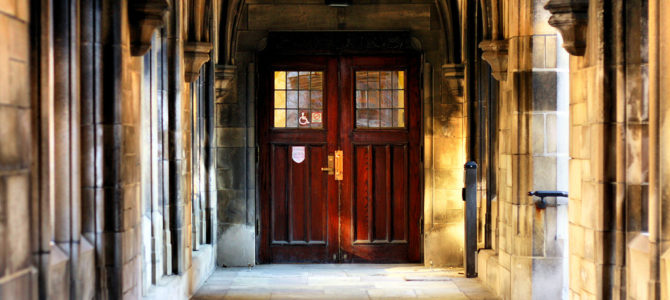
The campus visit is the modern equivalent of the medieval pilgrimage. We travel great distances to remote locations inhabited by the learned in hopes of finding direction, security, blessedness. And it will cost a fortune.
I remember feeling so bored tagging along on my older brother’s campus visits that I begged my parents not to take me on any for my own applications. They did take me, and though your kids may protest, you should go too.
But you, parent of the high school senior, ought to know: campus tours are designed to show you only the best and brightest aspects of each college, which you will soon discover share a bland similarity—but something is rotten in academia and you ought to be asking about it. To help you navigate and inform yourself, here is what I, as a faculty member, plan to do to hack the campus tour when my kids get older.
1. How to Grill Your Guides
Your campus tour guide is a walking, talking panegyric. Everything from the button-down shirt and slacks to the combed, washed hair and straight-toothed smiles, the individual standing before you is hand-selected to be the propagandist of the university. You would learn more about Captain Ahab by asking his parrot, who would at least screech “White Whale! White Whale!” than you would learn from the tour guide Ahab hired. The guide would talk about how Ahab was mission-focused, then show you the brand new hammocks below-deck.
Throughout the tour, ignore this person entirely. Focus rather on the strangers you can cajole into speaking with you. Ask strangers what the mission of the school seems to be. Hint: they will not know. When they answer with, “Uh, I guess we want to help the world while getting ready to make money,” that will be closer to the truth than the pamphlet.
But try asking more general questions about your concerns, too, like “How often can you cut class and pass?” These will get you a good sense of the campus experience. Bring a box of doughnuts to lure the undergrads into conversation. If you must stick with the guide, make every effort to throw the tosser off script by asking oddball questions, or even direct and personal questions. See if he blushes.
2. How to Inspect the Buildings
The tour will meander through campus but certainly include the newest buildings with the fanciest gadgets. As you enter a building, get the guide to say when the building was built. He may not know, in which case look it up on your phone and shout it out to everyone. Your teenager is already embarrassed by your mere presence, so giving him or her something to actually direct that embarrassment towards is actually a favor.
The goal here is to assess if this building is the normal building your student would be in. You may even ask if the guide has actually taken classes here. Often these tours will take you to beautiful spaces that are little used by undergraduates. This will be doubly true if it is a dorm.
You are better off asking passersby if they would show you their rooms in exchange for a doughnut. The difference between the staged room the tour shows you and the other room will be sizable. Remember, your child will not be staying in the staged room.
3. How to Take Stock of the Amenities
The campus tour will also take you to a variety of buildings, centers, and resources that sound wonderful. Wow, a new student recreation center, and look at that climbing wall! Look at the women’s resource center! And the blue light posts my beloved daughter can run to if she is being chased by a rapist—what a safe place this must be!
And there, the multicultural center that is going to instill tolerance and ensure that whatever my child is interested in, it will be available— and tightly controlled by the institution, for liability purposes. The counseling center, the writing center, the Campus Union, the organic garden, and on, and on, and on—why are they doing this? Don’t bother asking, because the 19-year-old guide in front of you doesn’t know.
The short answer is that as college has become more and more focused on the consumer (students and parents) it has had to diversify its offerings. As other schools do the same, the school you’re at now has had to keep up with the Joneses. They know that parents love the kids, and the kids want to have fun, so everyone has agreed that schools ought to focus on user experience where possible.
If you’re wondering, yes, this is a big reason tuition has exploded in recent years. Each of these centers is run by administration members. This has expanded the administration beyond imagination. In fact, most of the college’s employees are administrators. This is a key question to ask: “What percentage of tuition is spent on instruction at this school?”
Be prepared to be disappointed. Between the proliferation of these new amenities and the rise in the absolute pay of the core administration, your campus is likely to be spending less than a third of the money you’re paying on “instruction.” Try asking, “How do you define instruction?” and you may get hauled away by campus security. Pennies on the dollar are going to motivate the faculty to deliver what I assume you want for your precious little one: an education.
4. Try Out the Blue Light Phones
Try pressing the button on one of these. There is a good chance they don’t work. Ask if the tour guide has ever used one. He or she will say no. Then ask if the guide has ever heard of anyone using one. He or she will say no again.
This time it’s a lie, because every campus has someone who presses the button as a prank when he’s in his cups of a night (meaning drunk, but in a classy way). The blue light phone is a great place to keep the guide on his heels. Ask him if the campus is safe, and when he says yes, ask then why do they need the phones. Rinse and repeat.
5. How to Examine the Quality of the Faculty
Guides can get away with showing off the amenities because the average prospective college student and parent are living with the same false assumption: that there are actual faculty actually teaching here. This is reinforced by both the experience of the parents who were at these universities when they used to have faculty who used to teach and by the never-ending stream of films, movies, and books about college.
Everything from “Monsters University” to the National Lampoon series to “Good Will Hunting” depicts faculty as tough, but caring; wise and learned, hardworking, but always free to lend an ear to a young mentee. This is almost always in the ubiquitous “professor’s office”: wood-paneled, book-lined, and always with an extra chair for a pupil to come rest in for a chat.
Sorry to burst your bubble, but it just ain’t so. More than 70 percent of the faculty are now more or less adjuncts, and most teach at more than one university. While on the tour, offer the first professorly person you see a doughnut. She will not refuse, because she is likely making so little money that she skipped breakfast to make ends meet.
Ask if you can see her office. When she looks at you puzzled, with doughnut crumbs falling from her mouth, apologize, because she thinks you’ve just mocked her. Then explain that you meant to say: “Take me to where you meet with students.” You will be led to either the campus coffee shop, or the library, or to the faculty member’s car.
Hopefully for your child’s sake, it is parked by a blue light post. In rare cases there will be an office. Note how many names are on the door. If it is less than 14, you are in luck. You have stumbled upon a university that cares about the learning environment.
Then sit in one of the chairs and ask whether this is the kind of place your child is likely to visit often. Are there windows? Desks for faculty? Pictures of kids? Or does it look like a call center in India? Hint: it will look like a call center. Welcome to the salt mines of academia.
Try the inverse approach to getting the vibe of the educational environment, too. Ask a student if he’s made any significant relationships with faculty on campus, if he knows where his professor’s office is, etc. Parents, if you’re paying for an education and care about the quality thereof, pay attention.
6. How to Inspect Grades
Ask the guide what his GPA is. It will be much higher than yours was when you graduated. Don’t be impressed; it is called grade inflation. But I do recommend you asking what his major is then asking some questions you think he ought to know in that field. Watching him flounder is another one of those wonderful moments of insight.
Yes, all those part-time faculty, and the full-timers, have worked the system into a tontine. Students pretend to learn, faculty pretend to work, and parents (and the future students via debt) foot the bill to keep things moving along. Don’t believe me? Look at the Ivy League, where the vast majority graduate with high honors. This is bad.
It is made worse by the fact that those administrators who make the most money are evaluating whether to even let the faculty stay in their jobs based on student evaluations. These evaluations are predictably better for faculty who are easy graders, which motivates everyone to slack off just a bit more. The tenured faculty already don’t care: they’re employed for life, and the contingent faculty are working other jobs as key sources of income, so they don’t have time to grade harshly anyway.
Meanwhile, students are under the false assumption that their GPA matters greatly and thus they will torment any faculty seen as strict graders. To ferret this one out, go around asking students their GPA and whether they like their classes. Encourage your child to attend the school with the lowest average GPA where students are still in class. I know a recent grad of a top-tier college who finished his history degree with honors and wondered why he hadn’t learned anything. So there you are.
7. How to Ferret Out a School’s Real Values
The college will have a huge section of its website dedicated to things like values, and the mission statement, and goals for students or outcomes. This is overwhelmingly hogwash. I remember being dropped off at college. My father laid a hand on my shoulder and said, “Become adequate for life. You have four years.”
This was immeasurably better advice than the college website, which said, “Join an internationally renowned community inspiring new ways of thinking and solving global challenges.” By the end of college I still didn’t know what the college’s motto was supposed to mean, and I certainly didn’t know how to act on it. I did, though, know how to write, read, balance a checkbook, and cook dinner.
Think about what you hope your kid will be like in four years. Think about what values you have tried to foster: religious, political, and cultural. Try to find out if this is a place where that will be able to happen.
Again, your guide will lie to you. Find students, and ask them what the classroom environment is like for people like you. Ask them if there is a club known for being active that has your sort hanging around and advocating for themselves. Sure, your kid may not want to get involved in the family identity, but if you’re spending a small fortune you may as well make sure the environment is conducive.
I’ve known religious families who were shocked to find out their denominational college was actively promoting things anathema to their faith and minority families who were appalled by the stories of discrimination from supposedly inclusive campuses. This homework pays off.
If this all sounds pessimistic, that’s because the situation in higher ed really is dire. It isn’t without consideration that tech genius Peter Thiel fingered higher ed as the next bubble in the U.S. economy to pop. But the reasons we send young people to college are intrinsic: young people are in a formational stage both socially and intellectually. Figuring out which campuses can actually get your teen to develop in the right direction and which ones are frauds can be done with some elbow grease and is worth the effort.
Most students think they are in college just to get a better job one day. Schools are just trying to stay in business, so will market anything to get your tuition check. As a parent, it is your job to be the first person casting a bigger vision for college. The vision of jobs training is just too small.
I suggest you offer a vision of college as a pilgrimage. The small pilgrimage of the campus visit is worth it only if you spend that time engaging with your child rather than with the facade of the campus. Listen to her, share your experience with her, scope out together how she can navigate from what she is now to what she longs for, and take her longings seriously. Students, and campuses, need vision. Start casting that vision on the college tour, and don’t forget the doughnuts.









